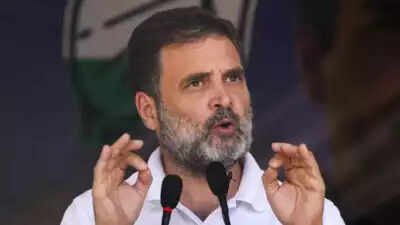New Delhi: congress leader Rahul Gandhi leave to Belagavi, Karnataka Attended from Delhi on Saturday conference working committee (Chemical Weapons Convention).
He will attend’Nav Satyagra Baisak“The conference will be held in Belagavi, Karnataka, on December 26 and 27.
Several other Congress leaders, including Karnataka Chief Minister Siddaramaiah and Deputy Chief Minister DK Shivakumar, arrived in Belagavi for the ‘Nav Satyagrah Baithak’ meeting.
Karnataka CM Siddaramaiah said: “To commemorate the 100th anniversary of the Congress in 1924, as we convene this convention here, the AICC has decided to hold the CWC meeting in Karnataka under the chairmanship of Mallikarjun Kharge.”
The Belagavi region was one of the geographical areas that contributed significantly to the freedom movement in India. According to Hindaraga Central Jail records, more than 2,060 freedom fighters were imprisoned during the Quit India Movement in 1942. that’s why mahatma gandhi He loved this area most and visited it six times in his life.
Freedom fighters, especially from Belagavi, Gokak, Baihungarh and Chikodi, played a key role in the freedom movement. Initially, most of the freedom fighters including Gangadhar Rao Deshpande were followers of Bal Gangadhar Tilak. After Tilak’s death in 1920, they became followers of Gandhi.
Gandhi’s six visits
Mahatma Gandhi visited Belagavi six times between 1916 and 1937. He stayed in the city from April 27 to May 1.
In 1924, he chaired the Congress National Conference in Belagavi. Party leader.
In 1934, he visited Nipani and stayed at the residence of Sevantibhai Shah on March 7.
In 1937, he camped for a week at the Kumari Ashram in Hudali from April 16 to participate in the “Gandhi Seva Sameran” activities. Gangadhar Rao Deshpande hosted the sammelan. Kumari Ashram is one of the six Gandhi Ashrams in the country. He was accompanied by Vallabhabhai Patel and Rajendra Prasad.
During the same period, the wedding of one of Gandhi’s granddaughters was also held at the ashram. Thereafter, he stayed at Murgod for one day and then at Mangalawar Peth in Belagavi city for four days.
The National Congress held in Belagavi in 1924 sowed the seeds of unity
This government is making every effort to mark the successful centenary of the 1924 Belagavi National Congress chaired by Mahatma Gandhi. The All India Congress Committee (AICC) working committee meeting will be held at the same venue where history was created 100 years ago.
The meeting marked Gandhi’s only tenure as Congress president and shaped the future of India’s freedom struggle. The 39th National Congress session held on December 26-27, 1924, attended by Jawaharlal Nehru, Lala Lajpat Rai ), C Rajagopalachari, Dr. Annie Besant, Sarojini Naidu, Maulana Abul Kalam Azad, Pattabhi Ra Pattabhi Ramaiah, Sardar Mangal Singh (Father of India).
One prominent local leader who participated in the event was Gangadhar Rao Deshpande. A close associate of Gandhi was the head of the reception committee for the 1924 conference.
settings
The conference covers an area of 80 acres, with a Vijayanagar-style temple building at the entrance and a large tent that can accommodate 5,000 delegates. Separate temporary huts were built with homespun clothes and bamboo roofs for important representatives to rest.
A huge kitchen was set up to prepare food. Shrikhand (a milk dessert) and puri are on the menu, along with rice and sambar. Thousands of lanterns and Petromax lamps were brought from Mumbai for lighting.
Kataka unification
The Belagavi session also invited famous singer Veene Seshanna to sing “Udayavagali namma chaluva Kannada Nadu” composed by Huyilagola Narayana Rao. By the way, in the choir was the famous singer Gangubai Hangal, who was 9 years old at the time.
transportation
The Madras and South Mahratta Railway has set up a temporary railway station near the conference venue to facilitate the travel of the delegates. Gandhi arrived at the venue in a huge procession in an open car provided by Jeevan Rao Yalagi.
expenditure
The total conference fee is Rs. 2,20,057. Funds were raised through membership and admission fees, sales of homespun products, and a number of donations, including from the King of Mysore and Marwari merchants.
Collection of surplus Rs.772 rupees. for food, and Rs 350 for construction of Gandhi Kutir at vaccine depot.
key decisions
It was at the Belagavi Conference that Gandhi revealed his formula of non-violence, non-cooperation and civil disobedience (satyagraha) against the mighty British.
More than 30,000 delegates from across the subcontinent across socio-economic, caste and religious divides attended the conference and pledged to free India from the clutches of British rule. In fact, “Vande Mataram” composed by Bankim Chandra Chattopadhyay was sung publicly for the first time by Pandit Vishnu Panth Paluskar along with other singers. During this meeting, 75 Brahmin volunteers acted as ‘bhangi’ workers to support Gandhi’s call for the elimination of untouchability.








